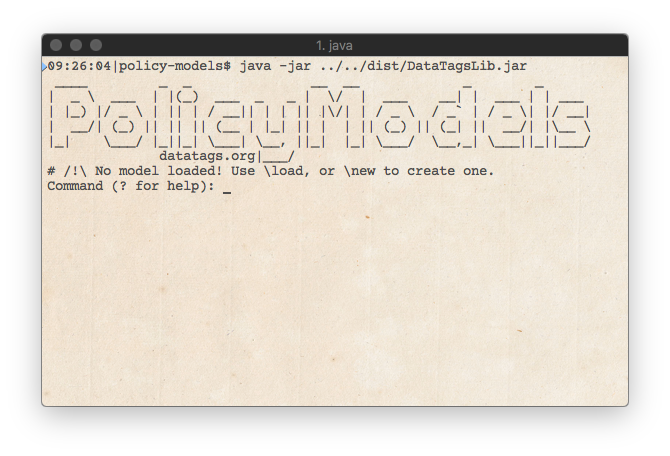CliRunner - PolicyModels Console Application¶
PolicyModels has a console application - that means it runs in a terminal and uses a text based, command line interface. The simplicity of this interface allows it to provide support for advanced language features early – developing graphic user interface takes time.
The PolicyModels console enables more than just going through an interview. It is a development environment, and offers powerful tools for the model developer. After the application is built (ant clean jar), the console application is available at dist/DataTagsLib.jar. You can run it by typing java -jar dist/DataTagsLib.jar from the DataTagsLib directory in the project.

There are two ways of loading an interview into the application. The first is to provide the path to a policy model directory, or to a policy-model.xml file, aa a parameter:
java -jar dist/DataTagsLib.jar path/to/policy-model/directory
If these parameters are omitted, the console app asks for them.
Once the model is loaded, the application starts the interview. The user can type the answers. But there are special characters as well - typing ? shows a list of available commands and their shortcuts:
Reading definitions: WORK/dtl/0.8/definitions.ts
(full: WORK/dtl/0.8/definitions.ts)
Reading decision graph: WORK/dtl/0.8/questionnaire.dg
(full: WORK/dtl/0.8/questionnaire.dg)
# Run Started
Do the data concern living persons?
Possible Answers:
- yes
- no
answer (? for help): ?
Please type one of the following commands:
\about: (\i)
What's this application all about.
\ask: (\a)
Prints the current question again.
\current-value:
Print the current tags to the console.
\debug-messages:
Toggles printing of debug messages.
... continued ...
Commands are executed by typing their name, preceded by \ (e.g. \about for the “about” command). Common commands have shortcuts. These are shown, when available, in parentheses near the command name. Some commands expect parameters; these are passed after the command name, like so: \show-slot Name/Of/Slot.
You are encouraged to read through the list. Some useful commands are highlighted below. Optional arguments appear in square brackets ([]).
Useful Commands for Users¶
- about
- Shows information about the current model and the application in general.
- current-tags
- Shows the current value of the tags.
- show-slot
- Displays information about a slot and its possible values. Usage:
\show-slot Name/Of/Slot. - restart
- Start the model execution again. Also available via
\r. - ask
- After some information is printed to the console, you may forget what the question was. Don’t scroll up - use
\askand the console app will happily ask you again. Don’t like typing so much? Use\a. - show
- Open the model’s directory using the operating system’s file browser.
Useful Commands for Developers¶
- new
- Creates a new model. Model metadata are populated using an interactive interview. Use
-qto skip the interview and have CliRunner fill out whatever it can (you can edit update the policy-model.xml later).\newtakes an optional parameter: the path to the new model’s directory. - reload
- Reload the model, e.g. after some changes were made. Also available via
\rr. As the common practice for developing a model is to keep a Tags console running the questionnaire while editing it, this command is very useful. - find-runs
Allows querying the questionnaire with questions like “which sets of answers would end up in a policy that allows clear storage?”. Takes a tag value as a parameter (similar to those used in set nodes). Finds all the runs (i.e. sequences of nodes and answers) that will end up with a tag value that is a superset of the supplied tag. A tag value a is a superset of a tag value b if they both agree on the values in b’s non-empty slots. In other words, a slot in a must have the same value as the corresponding slot in b, unless that slot in b is empty, in which case the slot in a can have any value (or be empty as well).
Example:
\find-runs Storage=clear; Transit=encryptedwill return all the run traces that will end up in a policy that requires clear storage and encrypted transmissions. Note that even for medium-sized interviews, this query can take a long time.- validate
- Validates the interview: Finds unused tag values, invalid call nodes, and unreachable nodes.
- trace
- The run so far
- visualize-ps, visualize-dg
- Create a visualization of the policy space (-ps) and the decision graph (-dg). Requires Graphviz. Use the flag
-style=f11to create a visualization using an alternative style, developed for Force11’s decision trees working group. The default file type for the visualization is PDF. However, it is possible to use other formats by specifying a filename with a different suffix when prompted for a filename. For example, naming a filemyDecisionGraph.svgwould make CliRunner generate the visualization in SVG format.
Tip
It is also possible to obtain the raw graphviz output, by supplying a .dot or .gv suffix.
- loc-create [localization-name]
- Creates a localization of the current model. CliRunner creates localization files with default and placeholder values that the model developer can edit using any text editor.